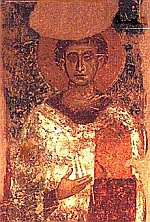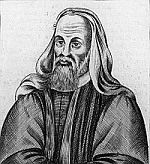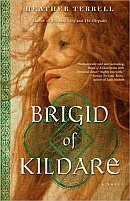Fiction
Modern and
Medieval
|
|

Pope Saint Simplicius
was pope from 468 to March 10,
483.
|

Arius (AD 250 or 256 – 336)
His teachings
about the nature of the Godhead, now referred to as
Arianism, provoked great controversy within the fourth-century Church
through their assertion that the Son of God, incarnate as Jesus Christ, was not consubstantial or coeternal with the Father.
|

Pelagius (ca. AD 354 – ca. AD 420/440) was an
ascetic who denied the doctrine of original sin as developed by
Augustine of Hippo, and was declared a heretic by the Council of
Carthage. His interpretation of a doctrine of free will became known as
Pelagianism.
|
|
|
|
|
|
Medieval
Book Reviews !
All
Things Medieval !
|
|
Brigid of
Kildare

by
Heather Terrell
Giraldus
Cambrensis, a 12th century writer, describes a beautiful manuscript
long assumed to be the Book of Kells. What if rather than the
Book of Kells, he discovered a second book lost to history? Would
this book tell a different story of women than the story of the
official one sanctioned Roman Christian Church?
Alexandra Patterson journeys to Kildare, Ireland in order to appraise
items from the Church of Saint Brigid. While examining a
reliquary box, Alex discovers a leather-bound manuscript. As Alex
tries to authenticate the date of the Book of Kildare, a book that
might predate the Book of Kells, the story of Brigid's life unfolds in
a separate parallel narrative through a saint's life and the letters of
Decius, a monk sent by Pope Simplicius, bishop of Rome, to spy on the
Abbey of Kildare. The pope commissions Decius to spy on this
abbey run by a woman to document the heresies practiced that threaten
the Roman Christian Church. As Ireland becomes a pawn in the
maneuverings of the Church, Brigid seeks to protect her country.
Baptized by Patrick himself, Brigid becomes a force for Ireland's
conversion to Christianity yet the relationship between Ireland and the
Roman Church is precarious at best, particularly in an age when the
Church's survival seems tied to the success of the Roman state
itself. The letters of Decius reveal a man drawn to Brigid and
her faith. Will he conspire against her or with her? Will
Brigid of Kildare be able to save the image of the woman from erasure?
Through alternating narratives, present and past, Heather Terrell's
BRIGID OF KILDARE presents a portrait of Brigid of Kildare as a bold,
unconventional leader who challenges the patriarchy of the Roman
Church. She questions a god who disregards the intelligence and
strength of women. Although forbidden as unorthodox centuries
earlier by Iranaeus, The Gospel of Mary the Mother provides Brigid with
an alternative understanding of Christianity, a Christianity where
women are not merely passive vessels or simply absent in the life of
Jesus. As a hybrid genre, BRIGID OF KILDARE will appeal
most to those readers who prefer fictional imagination over a more
purist view of historical fiction. If you are looking for
an imitation of THE DA VINCI CODE or other thrillers of this ilk,
BRIGID OF KILDARE is quite different in texture. While it lacks
suspense and the mad race to the finish of those thrillers, this reader
relishes the differences, particularly the author's use of medieval
literary forms such as the narrative of saint's life that added a
historical texture beyond historical facts and descriptions.
While some modern day readers may find these forms more dry than modern
fiction conventions, the historical narratives added a sense of mystery
and authentic feel for this medieval literature fan while also
inspiring the "what if" alternative feminist history thrill.
Perhaps this novel would have benefited from more character development
or more historical detail, but as it is, this medieval literature
enthusiast found BRIGID OF KILDARE a fun, light read with just enough
historical detail to inspire the imagination but not so much to include
it in a list of more substantial, more erudite medieval historical
novels. The present narrative interests the least although it
provides a framework for the juxtaposition of the other two
narratives. The mystery is not that mysterious, at least not in
terms of traditional mysteries, the romance not fully developed, the
subversion of the Roman Church's view on women not that subversive (at
least from today's perspective), and yet, I hate to admit it, after
reading countless medieval saints' lives in my past reading history,
this reader rather enjoys all those aspects other readers might label
dry. For this reader, the restraint and medieval literary
forms employed by the author make this novel do more than less.
Publisher: Ballantine Books (February 9, 2010)
|
Book description
Rich in historical detail, Heather Terrell’s
mesmerizing novel Brigid of Kildare is the story of the revolutionary
Saint Brigid and the discovery of the oldest illuminated manuscript in
the annals of the Church, a manuscript that contains an astonishing
secret history.
Fifth-century Ireland: Brigid is Ireland’s first and only female priest
and bishop. Followers flock to her Kildare abbey and scriptorium.
Hearing accounts of Brigid’s power, the Church deems her a threat and
sends Decius, a Roman priest and scribe, on a secret mission to collect
proof of Brigid’s heresy.
As Decius records the unorthodox practices of Brigid
and her abbey, he becomes intrigued by her. When Brigid assigns Decius
a holy task—to create the most important and sacred manuscript ever
made—he finds himself at odds with his original mission and faces the
most difficult decision of his life.
Modern day: Alexandra Patterson, an appraiser of medieval relics, has
been summoned to Kildare to examine a reliquary box believed to belong
to Saint Brigid. Hidden within the sacred box is the most beautiful
illuminated manuscript Alex has ever seen. But even more extraordinary
is the contents of the manuscript’s vellum pages, which may have dire
repercussions for the Catholic Church and could very well rewrite the
origins of Christianity.
|
|
|